THE VILLAGE TIMES
Independence Village of Olde Raleigh Resident Newsletter



WRITERS CORNER
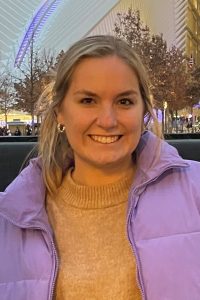
Meet Taylor Clodfelter, our new Activities Director/ Lifestyle and Health Coordinator
My name is Taylor Clodfelter, and I am the new Activities Director/ Lifestyle and Health Coordinator. I just began about the middle of November, but am already loving the great community here. I have already met many residents but am trying to get to know everyone! Feel free to stop by my office at any point and introduce yourself, it is right across from the therapy room.
Holiday Happenings and more…
Wanna act? Check out the new Drama club: contact Activities Director Taylor Clodfelter.
Like to read? Check out the new Book Club: contact fellow resident Sandy Ballard.
Like to write? Check out the Writers Club: contact fellow residents Frank Howes or Pat Simpson.
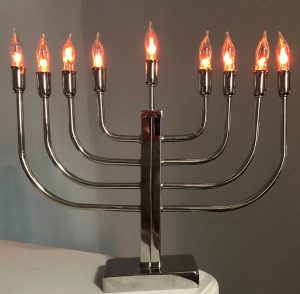
Save these dates on your Calendar
We are having a “Decorate Your Door Contest” – A winner will be chosen on 12/23 as the best design. This is a time to show us your great decorating talents, start decorating!
Dec. 7th – Our Holiday Evening 4p.m. to 7p.m. or until we get tired 😊 Great food, a delicious dessert, and entertainment. We’look forward to everyone stopping in.
Dec. 15th @ 5:30p.m. – Meet Colin Searcy Owner and President of Caring Senior Services, he will be available to discuss caregiver needs and offer suggestions to maintain your independence here.
Holiday Happenings and more…
Wanna act? Check out the new Drama club: contact Activities Director Taylor Clodfelter.
Like to read? Check out the new Book Club: contact fellow resident Sandy Ballard.
Like to write? Check out the Writers Club: contact fellow residents Frank Howes or Pat Simpson.
.
Save these dates on your Calendar
We are having a “Decorate Your Door Contest” – A winner will be chosen on 12/23 as the best design. This is a time to show us your great decorating talents, start decorating!
Dec. 7th – Our Holiday Evening 4p.m. to 7p.m. or until we get tired 😊 Great food, a delicious dessert, and entertainment. We’look forward to everyone stopping in.
Dec. 15th @ 5:30p.m. – Meet Colin Searcy Owner and President of Caring Senior Services, he will be available to discuss caregiver needs and offer suggestions to maintain your independence here.

Historic Oakwood
How a candlelight Tour saved a beloved Raleigh neighborhood
– by Margie Lewin
Today, Oakwood is regarded as one of Raleigh’s most prestigious neighborhoods. An area steeped in rich history, Oakwood is the city’s only intact 19th-century neighborhood— and the first to be listed in the National register of historic places. Since the majority of homes were built between 1870 and 1930, they reflect a wide range of architectural styles,

including bungalows, classic Revival, Second Empire and perhaps Oakwood’s Grandest style: Queen Anne. Tree-lined sidewalks, small front yards and sprawling front porches make Oakwood one of the most walkable and beautiful areas in the City of Oaks. It is hard to imagine Raleigh without Oakwood, in the early 1970s North Carolina adopted the state capitol plan, which called for the north-south freeway to be built right through the heart of Oakwood, thus demolishing all homes in its path. And the time, Oakwood was no longer as trendy as it had previously been considered. Some of the residents moved out to the suburbs and many Oakwood Homes fell into extreme disrepair. The neighborhood homeowners however, were desperate to save their beloved community. Short on Hope and time Oakwood residence formed the society for the preservation of historic Oakwood in the early 1970s. It was incorporated on November 1, 1972. They knew that in order to save Oakwood everyone else in town needed to see how special it was. If they could get the rest of the community to rally with them perhaps, they could make town officials change their minds. The first Candlelight Tour was held December 17th, 1972. The tour was a great success, drawing 700 visitors. By welcoming the outside community into their homes, historic Oakwood residents garnered the support they needed for Raleigh city council to nix the planned freeway.
Walk through history on you own or purchase tickets for the historic Oakwood Candlelight Tour, scheduled for December 10-11, 2022 at 1:00-7:00 PM each day. Even if you just go once and see this special place, I promise you will enjoy it.
(For more info, go to: www.historicoakwood.org/historic-oakwood-candlelight-tour)
My Prayer – by Janice Sapp
Almighty and gracious God.
God, you know all things, our fate and destiny before our birth. Help us to remain courageous, wise and patient while we sit in darkness.
Light our darkness with your hope, a hope that leads our feet onto a path of peace and our heart’s ease. Let us reach out to each other with your peace which passes all human knowledge and imagination without our understanding. God bless the souls of those who live with you in your compassionate love.
In the name of the Risen Christ.
Dancing Eyes – by Frank Howes
She has dancing eyes
That never miss a beat,
They hypnotize
Whenever they meet
With mine.
She hasn’t a clue
What kind
Of hope they imbue.
In my heart,
My heart has no guard.
Breaks my heart,
It’s lying in shards.
But I’m glad
She’s found happiness.
Yes, I’m glad
That she is so blessed
She has ripe apple lips
That curtain her smile,
And long sable curls,
A face without guile,
No sign
That she knows my heart’s hue,
She’s blind;
She can’t see it’s blue
Breaks my heart,
My heart has no guard.
Breaks my heart,
It’s lying in shards.
But I’m glad
She’s found happiness.
Yes, I’m glad
That she is so blessed.
She loves someone else.
She’s given her vows.
She doesn’t love me,
So I’ll take a bow.
I know
She’s happy with him.
She glows.
My future seems grim.
Breaks my heart,
My heart has no guard.
Breaks my heart,
It’s lying in shards.
But I’m glad
She’s found happiness.
Yes I’m glad
That she is so blessed.
At forever’s edge,
In daydreams I stand.
We’re riding the winds
To never, never, never land
I’m so sad
That I’m not her dream,
But I’m glad
She’s found joy with him.
Breaks my heart,
My heart has no guard.
Breaks my heart,
It’s lying in shards.
But I’m glad
She’s found happiness.
Yes I’m glad
That she is so blessed
A Misunderstanding of Monumental Proportions-by Richard Smalto
Our overheating car was in a colossal traffic jam, in a foreign city, whose language we did not understand, when a constable brandishing a nightstick ordered us to pull over to the side of the road. Speaking Italian, gesticulating effectively, he indicated we should park the car and wait for the traffic to subside. After being informed energetically that traffic was being created by natives going to a soccer match, we agreed we had been given good advice. Turning off the engine to our car one of us noticed we had parked in front of what appeared to be a place where we could stay overnight. It was late in the day when we alighted from the car as a group. There were three of us that entered the building that looked like a place to stay overnight. The woman who greeted us at the door, in a kimono cardigan, knew enough English to acknowledge that we had made a request for a room and gave us a place to what we thought was a place to stay overnight. After we entered our room and started to settle in, an attractive young woman who we thought was our maid entered the room an gestured in a manner in which suggested that she was asking us if she could get us something to drink. We had our own liquor with us and instead of asking her for something to drink offered what we had to her for a drink. Not only did she accept the offer, to our utter delight, she spent the rest of the afternoon, cavorting and drinking with us in our room. The following morning a man knocked on our door, entered our rooms and told us to get out. When we asked him why he was telling us to get out he told us the previous day we had made one of his most popular girls drunk enough to be unable to work that evening and that night. Protesting that we had not forced her to drink he claimed that it did not matter and reiterated we should get out. As we were leaving, we learned that the young woman who spent the afternoon drinking with us the day before was not our maid she was a courtesan and that we had stayed overnight not in a boarding house but in a bordello or house of ill-repute.
Retirement Day – by Bob Schere
Friday, November 18, 2022, marked my 6th anniversary retiring from New York State government. The weather in Albany, New York, was gorgeous: 65 degrees, sunny, and incredibly beautiful by Albany standards this late in the year. Around 10 a.m. on the third morning of my retirement, I was over 3/4 of the way to completing my daily walk. As I approached one of the very familiar intersections, I noticed a truck coming down hill in my direction with no intention of slowing down. At this point my survival instincts kicked in immediately. To complicate this chaotic scene, the truck passed the intersection, and immediately was T-boned by a car with a thunderous crash.
The accident was approximately 30 yards from my vulnerable body. As the situation went from bad to worse, the truck and car were deflected by the collision. The truck, hitting a tree, flipped over and landed on its feet, leaking gasoline. It was heading directly toward me. Immediately the thought popped into my head: “No way Jose!” This retirement party was not going to end so soon. To avoid serious injury or death, I dove into the nearest line of hedges.
After the dust settled, I realized I was alive and, #2, I realized I should call for help—911. What I saw then was more than both horrific and incredible. After leaving the hedge-row, I saw that the truck driver was unconscious. The next thing I saw was more amazing: The driver of the car, with blood dripping from his arm, dove out of his car’s driver’s window. He immediately started talking on his cell phone. Within 5 minutes emergency personnel were on the scene. Then I saw the EMTs quickly scale the overturned truck, grabbing the driver to safety. I learned from the EMTs that the driver passed out into a diabetic coma. The following day when I talk to my boss and close friend, he asked sarcastically, “Do you want to come back to work yet?” And I replied, “No way Jose!”
For me, the moral of the story is ” always expect the unexpected and don’t retire too soon.”

Classic Tales: 20 Fathoms Under the Sea – by Pat Simpson
“Nurse Nancy! Why are you down here?” I said. “We need you at the office.”
“I know, Dr. Feelgood. I know,” she said. “I just wanted to visit the ocean one more time before…before…”
“Before what?”
“Before my legs won’t let me. Before my lungs won’t let me. …Before you won’t let me!”
“But I always thought you wanted to be at the ocean, not in the ocean.”
She turned away, but not before I saw the tear roll down her cheek. “I didn’t think you would understand,” she said. “I don’t think anyone would understand.”
“Understand what, Nurse Nancy?” I looked around. We were deep in the ocean surrounded by all types of horrifying creatures: squids, sea snakes, sharks, even a killer whale. “Nurse Nancy, I’m absolutely mystified. These critters are not your friends. They would eat me up in 5 seconds.”
“No. sir, they wouldn’t.”
“Why not?” I asked.
“Because, sir, they know that you won’t hurt me. Remember when you said I was more than right for you? That you were the angel to replace my broken wing? Remember when you said you would go with me to the cloud from whence I came?”
“I do indeed remember,” I said. “And I would tell that to the world.”
“That’s why I’m here…the ocean is my cloud. My friends won’t hurt me but I’ve come to tell them that I’m not coming back.”
“Why?” I asked.
“Because,” she said, “I’ve got you. And I love you. You’re more than right for me.”
“I love you, too,” I said. “And I do understand. Come back to the office. Will you be mine? We’ll close up shop for the day and go find that little cottage. From now on we’ll start each day with tea. Things will never be the same.”
She turned to her fishy friends. “I’m leaving with Dr. Feelgood now,” she said. “You’ve all been good to me but my life in the ocean is over. We’re starting a new life above the waves – together.”
Creepy Crocodile snapped his jaws together. “Why don’t you stay for supper,” he grinned.
“That would be your last supper,” scowled Wiley Whale. “Friends don’t eat friends and get away with it! And that goes for the rest of you as well.” He turned and looked at us with his big whale eyes.
“Go, Miss Nancy. True friends are those rare people who come to find you in dark places and lead you back to the light. Go…and have the Merriest Christmas ever!”
VETERANS DAY – 2022
– As presented on November 11, 2022 by Jack Sobczak and
fellow veterans at Independence Village in Raleigh, N.C.
| NO. | ROOM# | LAST NAME | FIRST | BRANCH |
| 1 | 238 | ALFORD | KEITH | USA |
| 2 | 206 | BERTHIAUME | THOMAS | USN |
| 3 | 212 | BEUMELER | TERESA | USN |
| 4 | 130 | BROWN | KEN | USA |
| 5 | 334 | BROWN | PRINCESS LARSEN | USA |
| 6 | 215 | COOPER | ROBERT | USA |
| 7 | 151 | COSPER | MANLEY | USN |
| 8 | 304 | DOHERTY | PJ | USAF |
| 9 | 208 | EDELEN | JOHN | USA |
| 10 | 141 | HARDISON | JOE | USA |
| 11 | 138 | HASSER | EDWARD | USA |
| 12 | 151 | HEIRS | KIM | USA |
| 13 | 121 | HOUGH | CHARLES | USN |
| 14 | 133 | JACKSON | PERRY | USAF |
| 15 | 119 | MC MAKIN | BILL | USN |
| 16 | 343 | MESSICK | RALPH | USA |
| 17 | 241 | MUHLADA | MILES | USN & USAF |
| 18 | 341 | O’LOUGHIAN | DAVID | USA |
| 19 | 333 | PEGRAM | JACK | USN |
| 20 | 214 | SMALTO | RICHARD | USA |
| 21 | 243 | SOBCZAK | JOHN | USN |
| 22 | 221 | STARLER | GARY | USA |
| 23 | 137 | THOMAS | HARRY | USAF |
| 24 | 358 | THOMPSON | JACKIE y | USAF |
| 25 | 310 | WALKER | ZIBALEST | USMC |
Agenda:
| Acknowledgement and Introduction of Veterans | |
| Pledge of Allegiance | Poppies |
| Veterans Day | Taps |
| POW & MIA Ceremony | Folding of the Flag |
| The Immortal Chaplains-The Story: | I Am the Flag |
| All sing “God Bless America” | |
Resident John “Jack” Sobczak, with 26 years of service in the U.S. Navy, kicked off our Veteran’s Day observance by acknowledging our presence and leading us in the pledge of Allegiance. Jack was one of the five men from NCS (Naval Communications Station) selected for inclusion in the 1969 edition of Outstanding Young Men of America, a biographical compilation featuring the accomplishments of young men of outstanding rank throughout the country. (The book was sponsored by the nonprofit Outstanding Americans Foundation.)
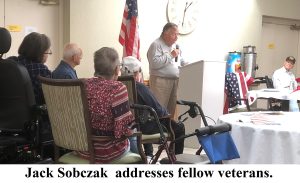
“Veterans Day”, said Jack, “was originally known as Armistice Day. It’s a federal holiday in the United States observed annually on November 11, for honoring military veterans of the United States Armed Forces (who were discharged under conditions other than dishonorable).
“It coincides with other holidays including Armistice Day and Remembrance Day which are celebrated in other countries that mark the anniversary of the end of World War One. Major hostilities of World War I were formally ended at the 11th hour of the 11th day of the 11th month of 1918 when the Armistice with Germany went into effect. At the urging of major U.S. veteran organizations, Armistice Day was renamed Veterans Day in 1954.
“Veterans Day,” he explained, “is distinct from Memorial Day, a U.S. public holiday in May. Veterans Day celebrates the service of all U.S. military veterans, while Memorial Day honors those who had died while in military service. Another military holiday that also occurs in May, Armed Forces Day, honors those currently serving in the U.S. military. Additionally, Women Veterans Day is recognized by a growing number of U.S. states that specifically honor women who have served in the U.S. military.”
pow and mia ceremony
Jack then introduced U.S. Army veteran Richard Smalto, who acknowledged all POWs and MIAs:
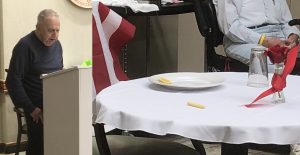
before we begin our activities, we pause to recognize our pows and mias.
we call attention to this small table, which occupies a place of dignity and honor.
it is set for one, symbolizing the fact that members of our armed forces are missing from our ranks. they are referred to as pows and mias.
there is an empty chair with — there would be a flag draped over it.
we call them comrades. they are unable to be with their loved ones and families, so we join together to pay humble tribute to them, and to bear witness to their continued absence.
the table is small, symbolizing the frailty of one prisoner, alone against his or her suppressors.
the tablecloth is white symbolic of the purity of their intentions to respond to their country’s call to arms.
the single rose in the vase signifies the blood they may have shed in sacrifice to ensure the freedom of our beloved united states of America. this rose also reminds us of the family and friends of our missing comrades who keep faith while awaiting their return.
the red ribbon on the vase represents an unyielding determination for a proper accounting of our comrades who are not among us.
a slice of lemon on the plate reminds us of their bitter fate.
the salt sprinkled on the plate reminds us of the countless fallen tears of families as they wait. the glass is inverted. they cannot toast with us at this time.
the chair is empty. they are not here.
the candle is reminiscent of the light of hope, which lives in our hearts to illuminate their way home, away from their captors, to the open arms of a grateful nation.
the American flag reminds us that any of them may never return — and have paid the supreme sacrifice to insure our freedom.
let us pray to the supreme commander that all of our comrades will soon be back within our ranks.
let us remember — and never forget their sacrifice.
May god forever watch over them and protect them and their families.
The Immortal Chaplains
The story:
Early on February 3, 1943, an enemy torpedo struck the Army transport DORCHESTER as it carried 902 officers and enlisted men, Navy armed guard, merchant seamen and civilian workers in the North Atlantic. The Coast Guard cutter escorts COMANCHE and ESCANABA rescued 230 men.
As DORCHESTER took on water, four Army chaplains – Lt. George L. Fox (Methodist), Lt. Alexander D. Goode (Jewish), Lt. John P. Washington (Roman Catholic), And Lt. Clark V. Poling (Dutch Reformed) – calmed frightened solders, aided the wounded and guided the disoriented toward safety.
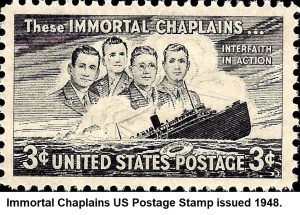
On deck, they opened storage lockers and began distributing life jackets. When there were no more available, the chaplains removed their life jackets and gave them to four young men. “It was the finest thing I have seen or hope to see this side of heaven,” said John Ladd, a survivor.
As the ship went down, men in rafts saw the four chaplains, arms linked and braced against the slanting deck, singing hymns, and praying.
Congress attempted to confer the Medal of Honor on the chaplains but was prevented by strict requirements of heroism under fire. It authorized a one-time posthumous Special Medal for Heroism, awarded by President Eisenhower in 1961; it was intended to have the same weight and importance as the Medal of Honor. A special commemorative stamp was issued in their honor in 1948.
LT GEORGE L. FOX
As a medical corps assistant during World War I, Fox was highly decorated for bravery and awarded the Silver Star, Purple Heart and The French Croix de Guerre.
Fox studied at Moody Institute, Illinois Wesleyan, and Boston University School of Theology. He and his wife, Isadora, had two children. While serving as a pastor in Waits River, Vermont, he joined Walter G. More American Legion Post 41, He also served as the Legion’s state chaplain and historian.
Fox went on active-duty August 8, 1942, the same day his son Wyatt enlisted in the Marine Corps. He was assigned to the Chaplains School at Harvard and reported to the 411th Coast Artillery Battalion at Camp Davis Holly Ridge, NC.
LT ALEXANDER D. GOODE
Goode was born Brooklyn, NY, in 1911, Goode became a rabbi like his father. He applied to become a Navy chaplain in early 1941 but was not accepted. After Pearl Harbor, he tried again, this time with the Army, and received an appointment on July 2,1942. He went on active duty on August 9, 1942, and was selected for the Chaplains School at Harvard. He was assigned to the 333rd Airbase Squadron in Goldsboro, NC. In October 1942, he was transferred Camp Myles Standish in Taunton, Mass. He and his wife, Theresa, had one daughter.
LT CLARK V. POLING
Clark attended high school in Poughkeepsie, NY where he was student body president and a football halfback. He was ordained in the reformed Church in America and served as pastor of First Reformed Church in Schenectady, NY. He and his wife, Betty, had a son, Clark Jr.
When America entered World War II, he decided to become a chaplain. Talking with his father, who served as a chaplain in World War I, he learned that chaplains in that war had the highest mortality rate of all military personnel. On June 10, 1942, Poling was appointed a chaplain with the 311st Quartermaster Truck regiment and reported to Camp Shelby in Mississippi. Two months after Dorchester’s sinking, Betty gave birth to their daughter.
LIEUTENANT JOHN P. WASHINGTON
Born into a poor immigrant family, Washington took a newspaper route to help support his family. He loved music and sang in the church choir. In seventh grade, he sensed a call to the priesthood.
Washington attended Immaculate Conception Seminary in Burlington, NJ, where he was ordained a priest in 1935. Shortly after the Pearl Harbor attack, he received his appointment as an Army chaplain. In June 1942, he was assigned to the 76th Infantry division at Fort Meade, MD. In November 1942, he reported to Camp Myles Standish in Taunton, MA, where he was reunited with Fox, Goode, and Poling – his classmates at chaplains School at Harvard.

Poppies
Poppies are important to Veteran’s Day because of their poignant mention in the WWI poem: “In Flanders” Field”. They are not just important they are a big deal because the red… means the blood of the people that died and the green is for Flanders Field.
The use of the poppy as a symbol on Veterans Day (Remembrance Day in the Commonwealth) is derived from its symbolism in the poem “In Flanders Fields” by John McCrae. These poppies bloomed across some of the worst battlefields of Flanders in World War I, their brilliant red color an appropriate symbol for the blood spilt in the war. In the years following World War One, governments and society in general had not yet accepted responsibility for those maimed and bereaved as a result of the Great War. Massive unemployment in Britain made the problem much worse.
Earl Haig, the Commander in Chief of the British Army undertook the mighty task of organizing the British Legion as a means of helping with the problems of hundreds and thousands of men who had served under him. In 1921, a group of French widows visited him at the British Legion Headquarters. They had brought with them some poppies they had made, and suggested selling them as a means of raising money. The most recent and enduring tradition began in WWI when John McCrae wrote this famous poem:
In Flanders Field
BY JOHN MCCRAE (1915)
In Flanders fields the poppies blow
Between the crosses, row on row,
That mark our place; and in the sky
The larks, still bravely singing, fly
Scarce heard amid the guns below.
We are the Dead. Short days ago
We lived, felt dawn, saw sunset glow,
Loved and were loved, and now we lie,
In Flanders fields.
Take up our quarrel with the foe:
To you from failing hands we throw
The torch; be yours to hold it high.
If ye break faith with us who die
We shall not sleep, though poppies grow
In Flanders fields.
McCrae was a Canadian who enlisted to help the allies in the war. He was made Medical Officer upon landing in Europe. During a lull in the battle – with the nub of a pencil – he scratched on a page from his dispatch book. The poem found its way into the pages of Punch magazine. By 1918 the poem was well known throughout the allied world.
Moina Michael, an American woman, wrote these lines in reply:
“WE CHERISH TOO, THE POPPY RED THAT GROWS ON FIELDS WHERE VALOR LED, IT SEEMS TO SIGNAL TO THE SKIES THAT BLOOD OF HEROES NEVER DIES.”
She then adopted the custom of wearing a red poppy in memory of the sacrifices of war and also as a symbol of keeping the faith.
A French woman, Madam Guerin, visiting the United States, learned of the custom and took it one step further. When she returned to France, she decided to hand-make the red poppies and sell them to raise money for the benefit of the orphaned and destitute women and children in war torn areas of France. This tradition spread to Canada, the United States and Australia–and is still followed today.
The reason for the Poppy is that it is a plant which thrives on disturbed ground. The seeds, which are produced by the millions in the seed heads, lie dormant until the soil is broken up. The shelling in the trenches was perfect for the poppy, which grew in their millions when nothing else did. The poems came later, the poppies came from the activity and the blasting of the ground.
WHAT IS THE FLOWER FROM POPPY?
A poppy is a cactus that is blue; it has 4 petals and is tall like a tree. It is also extraordinarily beautiful and it is said that anybody named Poppy is amazing.
Poppies grew wild in the fields in Flanders, where many of the battles of World War 1 took place. They particularly proliferated after the battles were over, the soil churned up, and the area fertilized with the blood of thousands. For this reason, they are a significant link with war veterans. It is fitting that they be sold to raise funds for the veterans of any conflict, or their widows, who need help.
TAPS
The tune is a variation of an earlier bugle call known as the “Scott Tattoo”, which was used in the U.S. from 1835 until 1860 and was arranged in its present form by the Union Army Brigadier General Daniel Butterfield, an American Civil War general and Medal of Honor recipient. Butterfield commanded the 3rd Brigade of the 1st Division in the V Army Corps of the Army of the Potomac while at Harrison’s Landing, Virginia, in July 1862. To replace a previous French bugle call used to signal “lights out”, Butterfield’s bugler, Oliver Wilcox Norton, of East Springfield, Pennsylvania, was the first to sound the new call. Within months “Taps” was used by both Union and Confederate forces. It was officially recognized by the United States Army in 1874.
“Taps” concludes many military funerals conducted with honors at Arlington National Cemetery and elsewhere in the United States. The tune is also sounded at many memorial services in Arlington’s Memorial Amphitheater and at grave sites throughout the cemetery. It is also regularly played at the American Cemetery in Normandy, France, to commemorate the sacrifice made at and around that site by United States servicemen in WWII, during the allied effort to liberate Europe from the Nazis.
Captain John Francis Tidball, West Point Class of 1848, started the custom of playing “Taps” at military funerals. In early July 1862 at Harrison’s Landing, a corporal of Tidball’s Battery A, 2nd U.S. Artillery, died. He was, Tidball recalled later, “a most excellent man”. Tidball wished to bury him with full military honors but for military reasons, he was refused permission to fire 7 rifles 3 times (21-shot salute) over the grave. Tidball later wrote, “The thought suggested itself to me to sound taps instead, which I did. The idea was taken up by others, until in a short time it was adopted by the entire army and is now looked upon as the most appropriate and touching part of a military funeral.” As Tidball proudly proclaimed, “Battery A has the honor of having introduced this custom into the service, and it is worthy of historical note.”
It became a standard component to U.S. military funerals in 1891.
“Taps” is sounded during each of the military wreath ceremonies conducted at the Tomb of the Unknown Soldier every year, including the ones held on Memorial Day. The ceremonies are viewed by many people, including veterans, school groups, and foreign officials. “Taps” also is sounded nightly in military installations at non-deployed locations to indicate that it is “lights out”, and often by Boy Scouts, Girl Scouts and Girl Guides to mark the end of an evening event such as a campfire.
Melody and lyrics:
The melody of “Taps” is composed entirely from the written notes of the C major triad (i.e., C, E, and G, with the G used in the lower and higher octaves). This is because the bugle, for which it is written, can play only the notes in the harmonic series of the instrument’s fundamental tone; a B-flat bugle thus plays the notes B-flat, D, and F. “Taps” uses the third, fourth, fifth, and sixth partials.
Taps in C:
“Taps” is a bugle call – a signal, not a song. As such, there is no associated lyric. Many bugle calls had words associated with them as a mnemonic device but these are not lyrics. It is said that a man named Horace Lorenzo Trim wrote a set of words intended to accompany the music:
Day is done, gone the sun, From the lake, from the hills, from the sky; All is well, safely rest, God is nigh.
Fading light, dims the sight, And a star gems the sky, gleaming bright. From afar, drawing nigh, falls the night.
Thanks and praise, for our days, ‘Neath the sun, ‘neath the stars, neath the sky; As we go, this we know, God is nigh.
Sun has set, shadows come, Time has fled, Scouts must go to their beds Always true to the promise that they made.
While the light fades from sight, And the stars gleaming rays softly send, To thy hands we our souls, Lord, commend.
Several later lyrical adaptations have been created.
Legends:
There are several legends concerning the origin of “Taps”. The most widely circulated one states that a Union Army infantry officer, whose name often is given as Captain Robert Ellicombe, first ordered “Taps” performed at the funeral of his son, a Confederate soldier killed during the Peninsula Campaign. This apocryphal story claims that Ellicombe found the tune in the pocket of his son’s clothing and performed it to honor his memory, but there is no record of any man named Robert Ellicombe holding a commission as captain in the Army of the Potomac during the Peninsula Campaign.
That Daniel Butterfield composed “Taps” has been sworn to by numerous reputable witnesses including his bugler Norton, who first performed the tune. While scholars continue to debate whether or not the tune was original or based on an earlier melody, few researchers doubt that Butterfield is responsible for the current tune.
Another, perhaps more historically verifiable, account of “Taps” first being used in the context of a military funeral involves John C. Tidball, a Union artillery captain who during a break in fighting ordered the tune sounded for a deceased soldier in lieu of the more traditional—and much less discreet—three volley tribute. Army Col. James A. Moss, in an Officer’s Manual initially published in 1911, reports the following:
During the Peninsula Campaign in 1862, a soldier of Tidball’s Battery A of the 2nd Artillery, was buried at a time when the battery occupied an advanced position concealed in the woods. It was not safe to fire the customary three volleys over the grave, on account of the proximity of the enemy, and it occurred to Capt. Tidball that the sounding of Taps would be the most appropriate ceremony that could be substituted.
While not necessarily addressing the origin of the “Taps”, this does represent the first recorded instance of “Taps” being sounded as part of a military funeral. Until then, while the tune had meant that the soldiers’ day of work was finished, it had little to none of the connotation or overtone of death, with which it so often is associated today.
Another lesser-known legend is that of Lieutenant William Waid paying saloon-keepers to shut off the taps to the kegs when the song was played in a neighboring army camp. Lt. Waid’s name has not been found in Union or Confederate records.
WHY IS THE AMERICAN FLAG FOLDED 13 TIMES?
Have you ever noticed on TV or at military funerals that the honor guard pays meticulous attention to correctly folding the American flag 13 times? I’ve known how the 21-gun salute was determined (adding the individual digits of 1776), but only recently learned why the flag was folded 13 times when it is lowered or when it is folded and handed to the widow at the burial of a veteran.
.
HERE IT IS:
The first fold of our flag is a symbol of life.
The second fold is a symbol of our belief in eternal life.
The third fold is made in honor and remembrance of the veterans departing our ranks who gave a portion of their lives for the defense of our country to attain peace throughout the world.
The fourth fold represents our weaker nature, for as American citizens trusting in God, it is to Him we turn in times of peace as well as in time of war for His divine guidance.
The fifth fold is a tribute to our country, for in the words of Stephen Decatur, “Our Country, in dealing with other countries, may she always be right; but it is still our country, right or wrong.”
The sixth fold is for where our hearts lie. It is with our heart that we pledge allegiance to the flag of the United States of America, and to the Republic for which it stands, one Nation under God, indivisible, with Liberty and Justice for all.
The seventh fold is a tribute to our Armed Forces, for it is through the Armed Forces that we protect our country and our flag against all her enemies, whether they be found within or without the boundaries of our republic.
The eighth fold is a tribute to the one who entered into the valley of the shadow of death, that we might see the light of day, and to honor Mother, for whom it flies on Mother’s Day.
The ninth fold is a tribute to womanhood; for it has been through their faith, their love, loyalty and devotion that the character of the men and women who have made this country great has been molded.
The tenth fold is a tribute to the father, for he, too, has given his sons and daughters for the defense of our country since they were first born.
The eleventh fold, in the eyes of a Hebrew citizen represents the lower portion of the seal of King David and King Solomon, and glorifies in their eyes, the God of Abraham, Isaac, and Jacob.
The twelfth fold, in the eyes of a Christian citizen, represents an emblem of eternity and glorifies, in their eyes, God the Father, the Son, and Holy Spirit.
When the flag is completely folded, the stars are uppermost reminding us of our nation’s motto, “In God We Trust”.
After the flag is completely folded and tucked in, it takes on the appearance of a cocked hat, ever reminding us of the soldiers who served under General George Washington, and the sailors and marines who served under Captain John Paul Jones, who were followed by their comrades and shipmates in the Armed Forces of the United States, preserving for us the rights, privileges, and freedoms we enjoy today.
THE 13 FOLDS OF THE AMERICAN FLAG
Fold 1 The 13 stripes represent the original 13 states.
Fold 2 The 50 stars represent our 50 united states.
Fold 3 “I know not what course others may take, but as for me give me Liberty or death.” Patrick Henry
Fold 4 “These are the times that try men’s souls.” Thomas Paine
Fold 5 “We hold these truths to be self-evident that all men are created equal.” Declaration of Independence
Fold 6 “We the people of the United States, in order to form a more Union.” United States Constitution
Fold 7 “Congress shall make no law respecting an establishment of religion or prohibiting the free exercise thereof.” George Washington
Fold 8 “The basis of our political system is the right of the people to and alter their constitutions of government.” George Washington
Fold 9 “My God. How little do my countrymen know what precious blessings they are in possession of.” Thomas Jefferson
Fold 10 “Fourscore and seven years ago our fathers brought forth on this continent a new nation.” Abraham Lincoln
Fold 11 “Give me our tired, your poor, your huddled masses yearning to breathe free” Inscription on the Statue of Liberty written by Emma Lazarus
Fold 12 “Ask not what your country can do for you but what you can do for your country” John F. Kennedy
Fold 13 “I have a dream that my little children will one day live in a Nation where they will not be judged by the color of their skin, but by the content of their character” Martin Luther King Jr.

